Looking for a Shopify alternative in 2025? You’re not alone.
Whether you’re frustrated with Shopify’s rising costs, limited design flexibility, or reliance on third-party apps, there are now powerful competitors that offer more control, better pricing, and smarter features often without the learning curve.
We’ve personally tested dozens of eCommerce platforms over the past year launching test stores, migrating existing sites, and building client funnels to find the best Shopify alternatives for real-world business needs.
Let’s explore the 7 best Shopify alternatives that actually deliver, whether you’re launching your first online store or scaling into B2B or enterprise territory.
💡 Bonus: Every platform here works seamlessly with OptinMonster, so you can grow your email list and boost sales no matter which one you choose.
How We Chose the Best Shopify Alternatives
At OptinMonster, we work with thousands of eCommerce businesses across all kinds of platforms, from solopreneurs just getting started to enterprise teams managing complex operations.
To create this list of Shopify alternatives, we used a combination of first-hand experience, industry research, and platform testing. Here’s what we considered:
- Ease of use: How beginner-friendly is the platform for setup and daily management?
- Pricing transparency: Does the platform offer good value for money, without hidden fees?
- Feature depth: Are advanced eCommerce tools like subscriptions, digital downloads, or multi-channel selling included?
- Scalability: Can the platform grow with your business, or will you hit a ceiling?
- Integrations: Does it work well with lead generation tools like OptinMonster?
- Reputation & support: Is the platform actively maintained, trusted by real businesses, and backed by good support?
We also looked closely at platform updates in 2024–2025, checking for new AI features, updated pricing, and changes in how each builder positions itself in the market.
💡 None of the platforms in this post paid to be featured. Our recommendations are based solely on what we believe will best serve our readers in 2025 and beyond.
TL;DR: Shopify Alternatives Compared (2025)
| Platform | Best For | Starting Price | Standout Feature | Biggest Tradeoff | |
|---|---|---|---|---|---|
| 🥇 | Wix | Beginners, small stores | $16/mo | AI-powered setup + 900+ templates | Limited backend flexibility |
| 🥈 | Squarespace | Creators, service providers | $23/mo | Built-in booking + email tools | Fewer integrations |
| 🥉 | BigCommerce | Scaling & B2B businesses | $29.95/mo | No transaction fees, native multichannel | Learning curve, pricing auto-upgrades |
| 4 | WooCommerce | WordPress users, developers | Free (core) | Unlimited flexibility + plugin ecosystem | Requires maintenance + tech knowledge |
| 5 | Adobe Commerce | Large enterprises | ~$22k/year | Enterprise-grade custom workflows | High cost + dev team required |
| 6 | Square Online | Brick-and-mortar + POS sync | Free | Easy POS + online store integration | Limited design/customization |
| 7 | Hostinger Builder | Budget-conscious solopreneurs | $2.99/mo | AI tools + Woo compatibility on a budget | Light on advanced features |
Best Shopify Alternatives – Detailed Review
1. Wix

Best for: Beginners and small businesses who want full design flexibility with minimal tech skills.
I recently tested Wix’s AI Site Generator while building a mock storefront for a side-hustle idea and honestly, it was one of the fastest setups I’ve ever experienced on an eCommerce platform. Within minutes, I had a branded layout, product pages, and a functioning cart. No plugins, no code, no guesswork.
Wix has evolved far beyond a basic website builder. In 2025, it’s one of the most user-friendly eCommerce solutions thanks to over 900 templates, AI-driven design tools, and a robust app marketplace. Whether you’re selling physical products, digital downloads, or subscriptions, Wix gets you online fast.
✅ What we liked when using it:
- The drag-and-drop editor is super intuitive — perfect for non-designers.
- Global payment support + multi-currency was surprisingly easy to configure.
- Built-in marketing integrations (like email and SEO settings) felt more native than plugin-based setups.
❌ Things we ran into:
- Larger product catalogs start to feel cramped in Wix’s backend.
- Access to advanced eCommerce features like subscriptions or multi-currency is locked behind premium plans.
- Backend customization is limited compared to WooCommerce or BigCommerce.
🆚 Compared to Shopify: Wix is easier to use and more affordable for small stores. It’s better for design freedom but lacks Shopify’s advanced inventory tools and app ecosystem.
💰 Pricing (2025 Plans):
- Business Basic – $16/mo: Online payments + core eCommerce
- Business Unlimited – $27/mo: Multi-currency, subscriptions, advanced analytics
- Business VIP – $59/mo: Priority support, loyalty tools, and more
💡 Wix is ideal if you want to go from idea to online store in under an hour, without writing a single line of code. For founders validating a new product or solo sellers, it’s a no-brainer starter platform.
2. Squarespace

Best for: Creatives, coaches, and service-based businesses selling digital products or subscriptions.
We recently helped a design client set up a Squarespace store to sell digital templates and coaching sessions. What stood out immediately was how streamlined the experience felt, from adding products to setting up Member Areas for client-only downloads. The visual quality of the site was top-tier, and everything “just worked” out of the box.
Squarespace isn’t just a portfolio site anymore. In 2025, it’s evolved into a full-featured platform with native tools for appointment scheduling, digital product delivery, email marketing, and even subscription management. It’s a solid choice if your business blends content, services, and commerce.
✅ Why we’d recommend it (from real use):
- Templates look like they were made by a designer — and editing them doesn’t break anything.
- Built-in email campaigns and Member Areas are perfect for creators monetizing their audience.
- The backend UI is probably the most intuitive of any platform on this list.
❌ What to keep in mind:
- There’s no free plan, and add-ons like Member Areas can raise your monthly cost.
- You won’t get the same level of plugin flexibility or third-party integrations as you would with WooCommerce or BigCommerce.
- Larger eCommerce catalogs may feel restricted by Squarespace’s layout system.
🆚 Compared to Shopify: Squarespace is ideal for service-based businesses and digital sellers, while Shopify is more powerful for physical product stores with complex inventory.
💰 Pricing (2025 Plans):
- Business – $23/mo: Basic eCommerce (includes transaction fees)
- Commerce Basic – $27/mo: No fees, label printing, and better analytics
- Commerce Advanced – $49/mo: Subscriptions, abandoned cart, advanced discounts
💡 Squarespace is perfect if your brand is part storefront, part content hub, and part service business. It’s especially strong for creators who want design polish without technical complexity.
3. BigCommerce
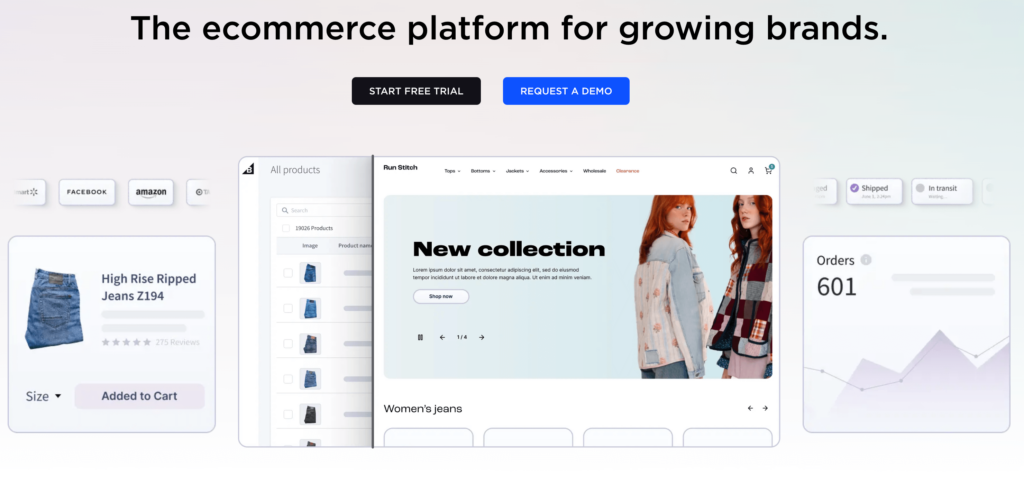
Best for: Scaling businesses and enterprise-level sellers who need robust features and flexibility.
We ran a client migration from Shopify to BigCommerce last year for a B2B retailer managing over 2,000 SKUs and the difference in backend power was clear. BigCommerce doesn’t rely heavily on third-party apps to deliver essential functionality. Features like customer segmentation, custom pricing tiers, and multi-storefront support are built-in, not bolted on.
In 2025, BigCommerce has doubled down on scalability, with advanced tools like B2B Edition, composable commerce architecture, and multi-channel integrations baked into the platform. It’s a great fit if you’re outgrowing beginner platforms or need serious backend performance without building custom stacks from scratch.
✅ From our experience using it:
- The native multichannel selling (Amazon, eBay, Facebook) setup was smoother than expected.
- Product and customer management tools scale beautifully — even for large catalogs.
- Unlike many competitors, there are no transaction fees on any plan.
❌ Challenges we noticed:
- The UI isn’t as sleek or beginner-friendly as Squarespace or Wix.
- Fewer themes and limited design flexibility unless you bring in a developer or use Page Builder heavily.
- Automatic plan upgrades based on sales thresholds can be a surprise if your store suddenly takes off.
🆚 Compared to Shopify: BigCommerce matches Shopify in features but includes many advanced tools (like multi-channel selling and B2B support) out of the box — no need for third-party apps.
💰 Pricing (2025 Plans):
- Standard – $29.95/mo: All core selling features, no transaction fees
- Plus – $79.95/mo: Abandoned cart recovery, customer groups
- Pro – $299.95/mo: Google Shopping, faceted search, custom SSL
- Enterprise – Custom pricing: Dedicated support, SLA, API enhancements, B2B suite
💡 BigCommerce is ideal for growth-focused businesses, especially if you’re managing high SKU volume, selling across channels, or building out a headless or B2B storefront. It’s built for scale, not side hustles.
4. WooCommerce
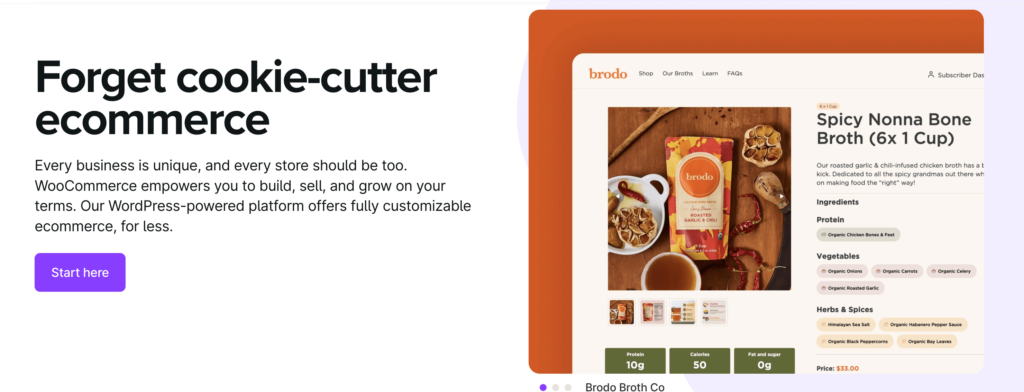
Best for: WordPress users and developers who want full control and flexibility.
As a content team that regularly tests lead gen workflows on WooCommerce, we’ve built dozens of stores using it and the biggest draw is still freedom. Whether you’re building a minimalist merch site or a complex subscription box business, WooCommerce lets you control every element: checkout flow, design, product pages, email automation, and more.
In 2025, WooCommerce has leveled up with tools like Woo Express (its hosted version) and Woo AI, which brings smart automation, product recommendations, and order insights directly into the dashboard. And because it’s built on WordPress, it’s still the best solution if your business is content-heavy.
✅ Why we still reach for WooCommerce:
- The ecosystem is unmatched — from SEO to payments, there’s a plugin for everything.
- Woo AI tools like product recs and analytics make the backend smarter without needing custom code.
- Woo Express helps users skip the headache of finding hosting or configuring basics.
❌ Where things get tricky:
- Without technical knowledge or a dev partner, scaling can be intimidating.
- Managing updates for plugins, themes, and WordPress itself requires maintenance.
- You’ll need to budget for extensions — many essential features aren’t included in the free core.
🆚 Compared to Shopify: WooCommerce offers more customization and control at a lower cost, but it requires more technical skill and WordPress knowledge to set up and maintain.
💰 Pricing (2025 Snapshot):
- WooCommerce Plugin – Free
- Hosting – $10–30+/month for quality managed hosting
- Woo Express:
- Essential – $39/month (Stripe/PayPal + bundled hosting/themes)
- Performance – $70/month (adds Woo AI, analytics, more storage)
💡 WooCommerce is the clear choice for anyone who loves WordPress and wants a completely customizable store. If you want total design and backend freedom and don’t mind getting under the hood, it’s unbeatable.
5. Adobe Commerce (Magento)

Best for: Large enterprises with complex catalogs, custom workflows, and in-house dev teams.
We worked with a client in the B2B medical supply space that migrated to Adobe Commerce from a patchwork of WooCommerce and custom tools and while the setup was intense, the payoff was massive. With Adobe Commerce, they gained a unified platform capable of handling bulk pricing rules, custom quoting workflows, and real-time ERP syncs without duct tape.
In 2025, Adobe Commerce is essentially Magento on enterprise steroids. It offers deep B2B capabilities, AI personalization through Adobe Sensei GenAI, and full integration with the Adobe Experience Cloud (think analytics, content, and marketing all in one ecosystem). This isn’t just eCommerce, it’s a commerce engine for brands that are already scaling globally or operating across complex channels.
✅ What we’ve seen firsthand:
- The ability to build composable commerce where you pick and integrate only what you need — gives unparalleled flexibility.
- AI-powered personalization and buyer segmentation is native, not an add-on.
- Headless capabilities and PWA Studio make performance and UX feel modern and fast.
❌ What to seriously consider:
- It’s not beginner-friendly. Implementation can easily take months and requires skilled developers or a dedicated agency.
- Total cost of ownership is high — licensing, hosting, maintenance, and integrations add up.
- For small-to-midsize stores, it’s overkill.
🆚 Compared to Shopify: Adobe Commerce is far more flexible and scalable than Shopify, but it’s also more expensive and requires dedicated development resources.
💰 Pricing (2025 Estimate):
- Adobe Commerce Cloud – Custom pricing (typically starts at ~$22,000/year)
- Open Source Magento – Still available for free but lacks premium support, AI, and enterprise features
- Add-ons – Hosting, security, development, and integrations may push annual costs into the six-figure range for large stores
💡 Adobe Commerce is the Ferrari of eCommerce platforms, powerful, fast, and customizable down to the engine. But like a Ferrari, it needs a pro behind the wheel. If your team is building for scale, speed, and full-stack integration, this is the platform that delivers.
6. Square Online

Best for: Brick-and-mortar businesses that want to easily sell online, too.
We recently helped a local bakery client launch a Square Online store in under a day, synced directly to their POS. No complicated setup, no juggling multiple systems. They were taking online orders and managing in-store inventory in one dashboard by the end of the afternoon.
That’s the magic of Square Online in 2025. It’s built for real-world businesses that want to unify offline and online sales without hiring a developer. It’s especially powerful if you’re already using Square for in-person transactions, the eCommerce layer just slides right into place.
✅ What worked well when we used it:
- The POS-to-online store sync is almost instant — no double entry for inventory or orders.
- Built-in payment processing (including Afterpay, Apple Pay) saves time and fees.
- AI product recommendations and abandoned cart tools are now available even on mid-tier plans.
❌ Things to be aware of:
- Design options are more rigid than platforms like Wix or Squarespace.
- Content marketing features (blog, SEO control) are fairly limited.
- Free plan includes Square branding and slightly higher transaction fees.
🆚 Compared to Shopify: Square Online is better for local businesses and in-person sales integration. Shopify has more advanced eCommerce features, but Square wins on simplicity and cost (including a free plan).
💰 Pricing (2025 Plans):
- Free – Basic store with POS sync and branding
- Plus – $29/month: Branding removed, more tools for shipping, SEO, and analytics
- Premium – $79/month: Lower processing fees, advanced shipping, more automation
💡 Square Online is perfect if you run a physical store and want to expand online without reinventing your workflow. It’s not the flashiest platform but it’s fast, dependable, and built for businesses that actually sell things, not just test ideas.
7. Hostinger Website Builder

Best for: Budget-conscious entrepreneurs launching their first store with the help of AI.
We recently tested Hostinger’s revamped builder to spin up a basic merch store for a personal project and for under $4/month, the results were shockingly good. The AI tools helped us auto-generate product descriptions, lay out pages, and even predict click heatmaps, no plugins required.
Hostinger has quietly become one of the most powerful Shopify alternatives for scrappy founders who want speed, affordability, and built-in AI. In 2025, their builder supports eCommerce, multilingual sites, WooCommerce integration, and marketing tools all running on LiteSpeed servers known for fast page loads.
✅ What stood out in our test build:
- The AI tools aren’t gimmicks, they actually saved time and made solid content suggestions.
- Pre-built templates looked clean on both desktop and mobile.
- Includes free SSL, domain, and email — something most platforms charge extra for.
❌ What you’re trading off:
- App ecosystem is minimal — you won’t find dozens of third-party integrations.
- Not designed for complex catalogs, subscriptions, or B2B needs.
- Some eCommerce settings (like tax rules, abandoned cart workflows) are more limited than in Shopify or BigCommerce.
🆚 Compared to Shopify: Hostinger is much more affordable and beginner-friendly, but lacks Shopify’s ecosystem and scalability. Great for simple stores or testing product ideas.
💰 Pricing (2025 Plans):
- Premium Plan – $2.99/month: Includes online store features, AI tools, email, SSL
- Business Plan – ~$3.99/month: Adds more storage, WooCommerce compatibility, marketing integrations
💡 Hostinger is a no-brainer for solopreneurs, freelancers, and side hustlers who want to launch quickly without committing to a $30+/month platform. It’s not Shopify but that’s exactly the point.
How to Choose the Right Shopify Alternative for Your Business
With so many great platforms available in 2025, choosing the right Shopify alternative really comes down to your specific needs. Here’s a quick guide to help you decide:
💼 1. What Type of Business Are You Running?
| Business Type | Best Platforms |
|---|---|
| Physical retail + online store | Square Online, Wix |
| Digital products or services | Squarespace, WooCommerce |
| Scalable product-based business | BigCommerce, Adobe Commerce |
| Freelancers / side hustlers | Hostinger, Wix |
| Agencies or enterprise teams | Adobe Commerce, BigCommerce |
🛠️ 2. How Much Customization Do You Need?
- Low customization, easy setup: Wix, Squarespace, Hostinger
- Moderate flexibility: BigCommerce, Square Online
- Full control / open-source: WooCommerce, Adobe Commerce
💸 3. What’s Your Budget?
- Free to low-cost: Hostinger, Square Online (free plan)
- Mid-tier: Wix, Squarespace, WooCommerce (self-hosted)
- Premium / enterprise: BigCommerce Pro+, Adobe Commerce
🌍 4. Do You Need Global or Omnichannel Support?
- Sell on Amazon, eBay, TikTok: BigCommerce
- Global payments + currencies: Wix, WooCommerce
- Local POS + online: Square Online
Shopify vs Top eCommerce Alternatives: Which One Wins?
| Platform | Where It Beats Shopify | Where Shopify Is Stronger | Best For |
|---|---|---|---|
| Wix | Easier setup, lower cost, more design freedom | Fewer apps, less suited for scaling | Beginners and small creative stores |
| Squarespace | Better for services, subscriptions, and design | Less inventory management & third-party integrations | Coaches, creatives, service sellers |
| BigCommerce | No transaction fees, built-in B2B and multi-store | Smaller theme library, learning curve | Scaling brands & multi-channel sellers |
| WooCommerce | Fully customizable, no monthly platform fees | Requires WordPress + tech knowledge | Developers, content-driven stores |
| Adobe Commerce | Enterprise-grade scalability & flexibility | High cost, complex setup | Large businesses with dev teams |
| Square Online | Free plan, POS sync, great for local sellers | Fewer features for advanced eCommerce | Small retailers with physical stores |
| Hostinger | Very low-cost, AI-powered setup | Limited app ecosystem & scalability | Budget-conscious beginners |
Use this chart to quickly match your business type and goals with the right platform — then dive into the full reviews above for details.
Summary:
- Choose Shopify if you need a robust, mid-to-enterprise level store with lots of app integrations and don’t mind paying extra for features.
- Choose an alternative if you want lower costs, easier setup, better design flexibility, or specialized features like services, subscriptions, or in-person selling.
Choosing the right eCommerce platform for your business is just a matter of examining your goals. And, no matter the platform you choose, you can depend on OptinMonster to convert interested visitors to customers. Get started with OptinMonster today!
FAQs About Shopify Alternatives
1. What is the best alternative to Shopify for beginners?
For beginners, Wix is a great Shopify alternative. It offers an intuitive drag-and-drop builder, AI store setup, and simple pricing; making it easy to launch an online store with no technical skills.
2. Is there a free Shopify alternative?
Yes, Square Online offers a completely free plan that includes online selling, POS integration, and mobile-friendly templates. It’s ideal for small retailers and service providers testing the waters.
3. Which Shopify alternative is best for digital products?
Squarespace is perfect for selling digital products or services like coaching, downloads, or subscriptions. It includes built-in tools for scheduling, member areas, and email campaigns.
4. Which platform is best for scaling a fast-growing eCommerce business?
BigCommerce is built for scaling. It supports multi-channel selling, B2B features, advanced SEO, and doesn’t charge transaction fees; making it ideal for stores expecting high growth.
5. What’s the most affordable Shopify alternative?
Hostinger Website Builder is one of the most budget-friendly options, starting at just $2.99/month. It includes eCommerce tools, AI features, and free SSL/domain; great for new or small shops.
6. Can I use OptinMonster with these Shopify alternatives?
Yes! OptinMonster integrates seamlessly with Wix, WooCommerce, BigCommerce, Squarespace, and more, allowing you to grow your email list, recover carts, and increase sales across all major platforms.

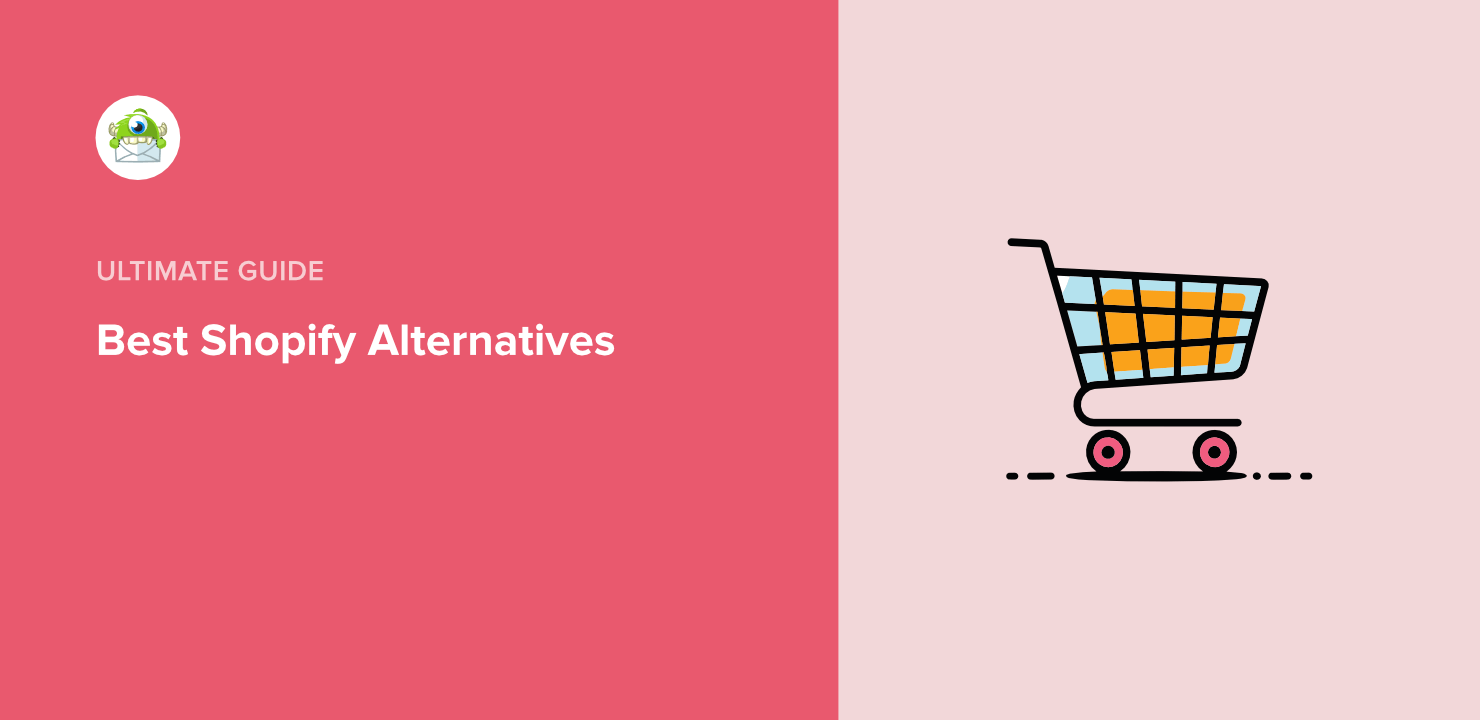
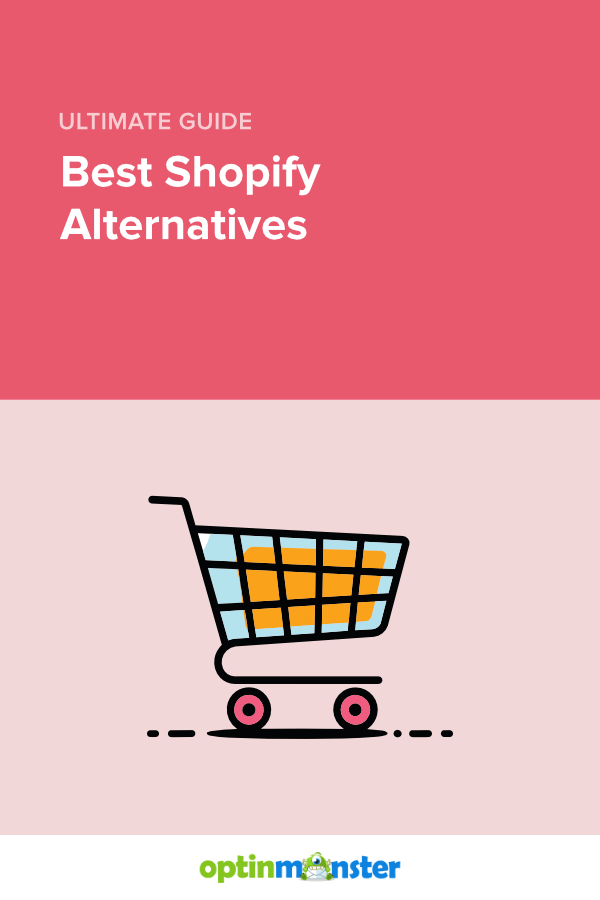


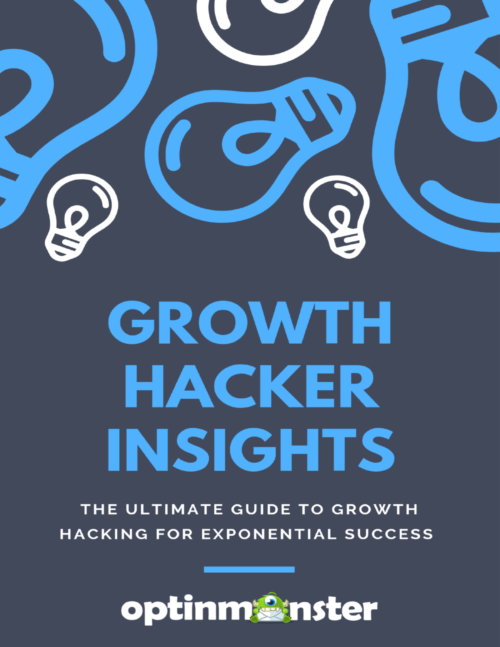

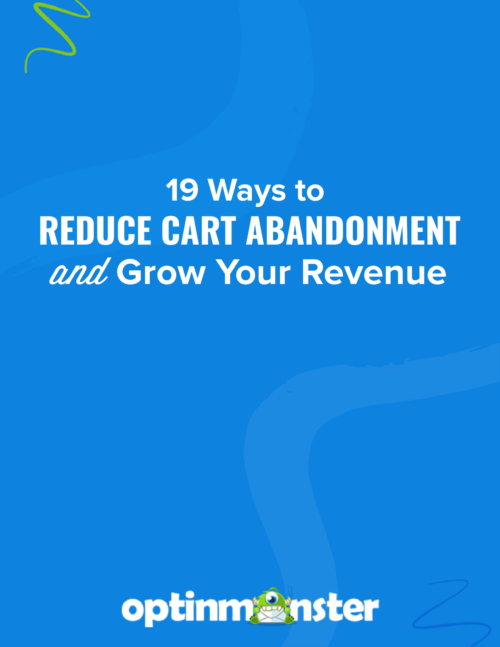



Add a Comment